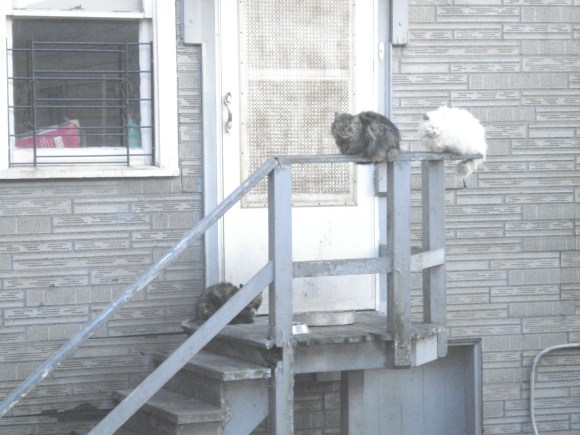Pulling Kittens from a Colony
When we started TNR on the Armando Colony, the feeders told us about the kittens inside the house.
There were two litters, seven kittens total ranging from four to six weeks old. The mama cats were not there. The feeder said one of the mama cats was hit by a car and killed just that week.
Heather and Melissa were able to get into the house to see what kind of shape they were in. They were all friendly, and absolutely beautiful.

But you can see that the tabby in back was starting to get sick.
Some of the kittens were already pretty sick. A few had extreme eye issues.

While I was taking the nine adult cats back and forth from the clinic for their TNR surgery, Heather and Melissa made several calls to the no kill shelter trying to see if we could also get these kittens admitted. This is why it was so great to work as a team – there was no way all of this could’ve been done at once otherwise.
The shelter agreed that the kittens with the worst eye issues should be vetted. Heather and Melissa took two of the kittens that evening to a full-service vet, and then returned them to the feeder with their meds. At this point, I was doing recovery for the eight adult cats in my garage. One had died during surgery.
The next day the shelter agreed to vet the remaining five kittens at their clinic. I went to the feeder’s house to pick them up. She came out swinging their carrier bag around. I just took it away from her as fast as possible.
I was so rattled by the situation that I didn’t realize all seven of the kittens were actually in the carrier until the clinic started examining them. The feeder never told me. I texted a photo to Heather to make sure that ALL of the kittens were accounted for that she saw on her initial visit. We are confident there are no kittens left at that house.
They were packed in tight and very squirmy. You can see that the orange kitten’s eye already looked a little bit better.
Meet Hepburn, Garland, Rooney, Astaire, Monroe, Lemoyne and Hirsch.

During this appointment, the shelter called and said they would admit all seven the next day. There was some confusion as to where they would stay that night, but it worked out in the end. There was no way I was going to take back these kittens to the feeder. They didn’t want them anyways.
I had to make this video of them in there. They are ridiculous.
Obviously they are adorable and quite a conversation starter. I was at the clinic for a few hours with them, and met quite a few people. One woman was there with her adopted cat from Feral Fixers. Another woman was there with a dumped cat that she found in Humboldt Park proper. After speaking to another woman for a few minutes, she suddenly said, “Wait, are you Cats In My Yard?!” THAT was fun. She said she found this blog inspiring. That made my day! She is doing TNR just south of me, yes! Hi, Maryann, it was wonderful to meet you!
Anyways, I also moved them into a bigger carrier because they had enough of that small space. And then they became impossible to photograph and wouldn’t sit still – I could only get blurry action shots. Check out the tortie in front, acting just like a typical tortie.

The kittens are safe now. Thank you, Heather and Melissa, for all of your hard work in saving their lives and taking them off the streets!




















































omg how adorable
Thanks for the update on the kittens. It was great meeting you and them. I think the whole experience inspired my young neighbor who helps me with the cats. We will be trying to trap TJ for a third time next week.
Thanks, Maryann, you made my day! We really need the next generation on our side doing this. Please contact me if you guys have any questions, or perhaps she would even be interested in hosting a TNR work shop at her school…? I would be happy to assist with that. Vanessa
OMG Vanessa, you are hysterical! You didn’t even tell me you took a video. Those little stinkers.
I lost my mind over those kittens. I couldn’t believe how many were in that carrier when I opened it up.